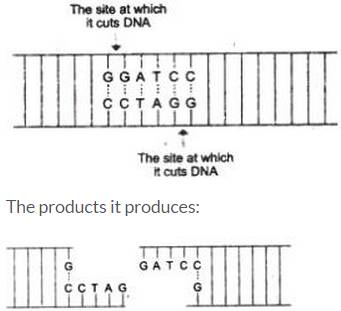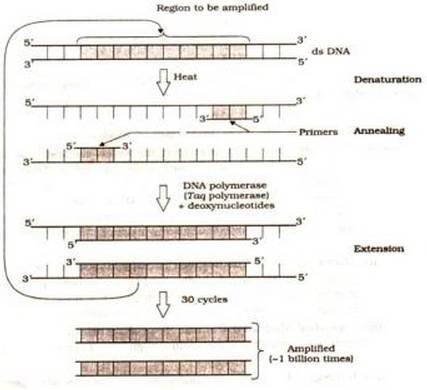Biotechnology Principles - Solutions
CBSE Class 12
Biology
Ch 11 – Biotechnology : Principles and Processes
1. Can you list 10 recombinant proteins which are used in medical practice? Find out where they are used as therapeutics (use the internet).
Ans.
Recombinant Proteins | Therapeutic uses |
(a) Insulin | Used for diabetes mellitus |
2. Make a chart (with diagrammatic representation) showing a restriction enzyme, the substrate DNA on which it acts, the site at which it cuts DNA and the products it produces.
Ans. The substrate DNA on which a restriction enzyme acts:
3. From what you have learnt, can you tell whether enzymes are bigger or DNA is bigger in molecular size? How did you know?
Ans. The molecular size of DNA molecules is more than that of enzymes. It is because an enzyme (protein) is synthesised from a segment of DNA called the gene.
4. What would be the molar concentration of human DNA in a human cell? Consult your teacher.
Ans. The average molecular weight of a nucleotide in human DNA is 130.86. The molecular weight of human DNA will therefore be 6 x 109 nucleotides (based on the human genome project) x 130.86 = 784.56 x 109 gm/mol. The molar concentration of DNA can be calculated accordingly.
5. Do eukaryotic cells have restriction endonucleases? Justify you answer.
Ans. No. Eukaryotic cells do not have restriction endonucleases. All the restriction endonucleases have been isolated from the various strains of bacteria and they are also named according to the genus and species of prokaryotes. The first letter of the enzyme comes from the genus and the second two letters come from the species of the prokaryotic cell from which they have been isolated.
6. Besides better aeration and mixing properties, what other advantages do stirred tank bioreactors have over shake flasks?
Ans. Shake flasks are used for growing microbes and mixing the desired materials on a small scale in the laboratory. However, the large-scale production of a desired biotechnological product requires large stirred tank bioreactors.
Besides better aeration and mixing properties, bioreactors have the following advantages:
i.It has an oxygen delivery system.
ii.It has a foam control, temperature and pH control system.
iii.Small volumes of culture can be withdrawn periodically.
7. Collect 5 examples of palindromic DNA sequences by consulting your teacher. Better try to create a palindromic sequence by following base-pair rules.
Ans. Some palindromic DNA sequences and the restriction enzymes which act on them are
(i) 5'-AGCT-3'AluI (Arthrobacter luteus)
3'-TCGA-5'
(ii) 5'-GAATTC-3'EcoRI (Escherichia coli)
3'-CTTAAG-5'
(iii) 5'-AAGCTT-3'HindIII (Haemophilus influenzae)
3'-TTCGAA-5'
(iv) 5'-GTCGAC-3'SalI (Streptomyces albus)
3'-CAGCTG-5'
(v) 5'-CTGCAG-3'PstI (Providencia stuartii)
3'-GACGTC-5'
8. Can you recall meiosis and indicate at what stage a recombinant DNA is made?
Ans. A recombinant DNA is made in the pachytene stage of prophase I by crossing over during meiosis cell division.
9. Can you think and answer how a reporter enzyme can be used to monitor transformation of host cells by foreign DNA in addition to a selectable marker?
Ans. Reporter enzyme can differentiate recombinants from non-recombinants on the basis of their ability to produce a specific colour in the presence of a chromogenic substrate. DNA is inserted within the coding sequence of the enzyme β-galactosidase. This results into inactivation of the enzyme which is referred to as insertional inactivation.
The presence of a chromogenic substrate gives blue-coloured colonies if the plasmid in the bacteria does not have an insert. The presence of the insert results in insertional inactivation of β-galactosidase and the colonies do not produce any colour. These are identified as recombinant colonies.
10. Describe briefly the following:
(a) Origin of replication
(b) Bioreactors
(c) Downstream processing
Ans. (a) Origin of replication (ori): This is a sequence from where replication starts and any piece of DNA when linked to this sequence can be made to replicate within the host cells. This sequence is also responsible for controlling the copy number of the linked DNA. So, if one wants to recover many copies of the target DNA it should be cloned in a vector whose origin supports a high copy number.
(b) Bioreactors: Bioreactors are vessels in which raw materials are biologically converted into specific products, individual enzymes etc. using microbial plant, animal or human cells. A bioreactor provides the optimal conditions for achieving the desired product by providing optimum growth conditions (temperature, pH, substrate, salts, vitamins, oxygen). The most commonly used bioreactors are of stirring type. A biogas plant is a good example of a bioreactor.
(c) Downstream processing: After completion of the biosynthetic stage, the product is subjected through a series of processes before it is ready for marketing as a finished product. The processes include separation and purification, which are collectively referred to as downstream processing. The product has to be formulated with suitable preservatives. Such formulation has to undergo thorough clinical trials as in the case of drugs. Strict quality control testing for each product is also required. Downstream processing and quality control testing vary from product to product.
11. Explain briefly
(a) PCR
(b) Restriction enzymes and DNA
(c) Chitinase
Ans. (a) process of polymerase chanin reaction (PCR).:enaturation: Double-stranded DNA is converted to single-stranded DNA, often achieved by heating or alkaline conditions. This is called 'melting' of DNA.
ii.Annealing: The two sets of primers undergo the biochemical process of annealing at an optimum temperature of 40-65?C.
iii.Extension: The enzyme DNA polymerase extends the primers using the nucleotides provided in the reaction and the genomic DNA as the template.
If the process of replication of DNA is repeated many times, the segment of DNA can be amplified to approximately a billion times. Such repeated amplification is achieved by the use of a thermostable DNA polymerase and the amplified fragment if desired can be used to ligate with a vector for further cloning.
(b) Restriction enzymes and DNA: Restriction enzymes are synthesised by microbes as a defence mechanism and are specifically endonucleases which cleave the double-stranded DNA with the desired genes. This activity occurs at a limited number of sites depending on the number of recognition sequences in DNA. Lysing enzymes, synthesising enzymes (DNA polymerase and reverse transcriptase) and ligases are also tools of genetic engineering.
(c) Chitinase: During the isolation of DNA in the processes of recombinant DNA technology, the fungal cell is heated with an enzyme called chitinase. The chitinase enzyme dissolves the chitin membrane to open the cell for release of DNA along with other macromolecules such as RNA, proteins, polysaccharides and lipids.
12. Discuss with your teacher and find out how to distinguish between
(a) Plasmid DNA and Chromosomal DNA
(b) RNA and DNA
(c) Exonuclease and Endonuclease
Ans. (a)
Plasmid DNA | Chromosomal DNA |
Plasmid DNA is the naked double-stranded DNA which forms a circle with no free ends. It is associated with few proteins but contains RNA polymerase enzyme. They are smaller than the host chromosomes and can be easily separated. | Chromosomal DNA is a double-stranded linear DNA molecule associated with large proteins. This DNA exists in relaxed and supercoiled forms and provides a template for replication and transcription. It has free ends represented as 3'-5'. |
(b)
DNA | RNA |
i.It is mainly confined to the nucleus. A small quantity occurs in mitochondria and chloroplasts. ii.Its quantity is constant in each cell of a species. iii.It contains deoxyribose sugar. iv.Its pyrimidines are adenine and thymine. v.The amount of adenine is equal to the amount of thymine. Also, the amount of cytosine is equal to the amount of guanine. vi.It can replicate itself. | i.It mainly occurs in the cytoplasm. A small quantity is found in the nucleus. ii.Its quantity varies in different cells. iii.It contains ribose sugar. iv.Its pyrimidines are adenine and uracil. v.Adenine and uracil are not necessarily in equal amounts, nor are cytosine and guanine necessarily in equal amounts. vi.It cannot replicate itself. It is formed by DNA. Some RNA viruses (paramyxo virus) can produce RNA from an RNA template. |
(c) Exonucleases are nucleases which cut off the nucleotides from the 5' or 3' ends of a DNA molecule, whereas endonucleases are nucleases which cleave the DNA duplex at any point except at the ends.